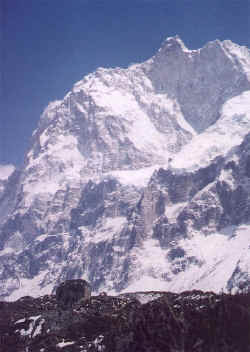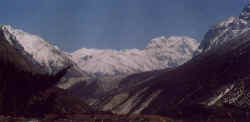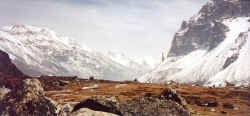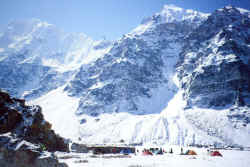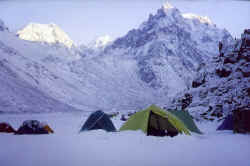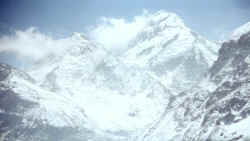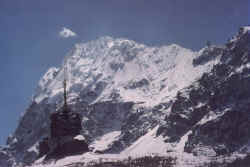MyHimalayasimpressions from |
|
|||||||

Walking up the glacier to Jannu base camp. Climbing this face is considered to be one of the most difficult climbs. Any guesses why?
Dark moraines stand out against the white peaks as we approach Lhonak. The peak at the right is Drohmo, Tnegkoma is on the left of this ridge.
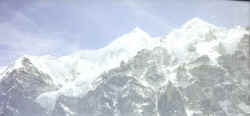
Merra peak with its impressive glaciers.
Valley just before reaching Lhonak, Tengkoma is the rock/snow summit at the left..
Our camp site for the next few days, usually it snowed only at night and it melted in the warm sunshine during the day.
Wedge Peak in Joel's sunglasses.
Sunrise in Lhonak after a cold, snowy and windy night..
A little snow fell over night and makes the scenery even more enchanting.
View of the Twins ??? from Pangema.
Wedge Peak from Lhonak.
Kangchenjunga: Lhonak - Pangpema
Kangbachen - Lhonak - Pangpema
Kangbachen Rest day (Day 10)
I have to get up in the middle of the night. The sky is clear, not a single cloud hides the Milky Way and the endless stars, the bright light of full moon illuminates the stunning mountains. I feel a little sorry for people who's bladder is so strong that they sleep through and never get to enjoy the views at night.
Bells wake me one hour before breakfast, for awhile I enjoy lying on the big comfortable planks (yes, it is a bed). When I get up the older yaks are already on the way to the pastures, only young yaks stay in the village. I expected to see more of them because agriculture seems impossible up here and husbandry could be a profitable business.
The village gives a partly abandoned impression, it is not inhabited in winter but I wonder if it is much busier in summer. The Indian pundit Chandra Das described barley fields when he came through on his way to Tibet as a 'spy' for the British. But that was 1879, these days only moraines and stones surround the village.
Clouds cover the sky, only some peaks are brightly lit. A good excuse not to go for a long dayhike. After lingering around for some hours after breakfast, we decide to go for a short hike. Just behind the village is a ridge that blocks the view towards north. Small trails go up through the shrubs to a chorten and some prayerflags which the end of the short climb, during which we felt the altitude. My heart is beating faster and the breathing increases, usual symptoms of altitude. Except for Dave who has a severe cold everybody is fine. From here the views to the north are impressive: the valley becomes wider, the remains of a wide glacier comes towards us, behind it rise snow-covered peaks of various heights, Tengkoma is one of the smaller peaks, Drohmo by far the largest one at the Eastern end of the valley.
We follow the yak trails that traverse the hill, a steep rock mountain rises to the right, below us to the left is the old moraine with a small creek named Nupchu ("West-River" in Tibetan). The others walk slower and since they plan to take for a longer tour, I go on independently. A ridge is blocking the way and I descend to the valley where large sand banks and some pools look like an inviting place for swimming... if it wasn't snowing and the pools weren't partially frozen. On warm days in autumn it must be a great place to hang out: spread your towel, and take a nap with views of 7'000 m peaks. The only one swimming there right now is a lonely brown duck. According to the map there are large glacial lakes at the end of this valley, but the walk there would be long and it is unlikely that the weather will get better. I turn around but miss the trail that I saw from higher up, so I just follow the Nupchu Khola towards our camp. Jumping from boulder to boulder across the water is a good exercise for concentration and leg muscles.
My timing was perfect, the short walk offered good views towards Lhonak, increased my appetite and I'm back in camp just before lunch. While enjoying dal baht once more, the cloud cover breaks and the remaining clouds make the stupendous walls of Jannu even more impressive. The turbulence in the air - only visible because of the fog - around the summits makes their height and wildness more tangible. I must have looked intensely at these mountains dozens of times every day, and still found something new every time. Incredible.
The views are too tempting to remain in camp, in the middle of the afternoon a small group sets out for the Jannu glacier. Crossing the creek on two planks (each three-inch wide) is a little tricky. It is half a mile from camp to the foot of the black slope; we soon give up a shortcut because of thorny bushes. Some snow lies on the glacier, from the crest of the black ridge we look down into a large area of ice and debris 30 meters below us.
The differences of temperatures are very large in the Himalayas, this cracks the rocks on the mountain flanks and thus much rubble covers the glacier. Going down to the glacier from here would be too dangerous because of the constant rockfall, so we decide to walk a little bit further up on the ridge for better views of Jannu. After crossing some patches of wet snow, the others decide to turn around and I go a little further. Snow, mud, stones, and many creeks require some attention, but it takes some effort to take the eyes from Jannu and concentrate on the trail.
Eventually I turn around earlier than planned, the wind is freezing cold and clouds have moved in. Instead of taking the way on the ridge I follow the foot of the moraine, then through the shrubbery and eventually cross the two wooden planks. A little tired and am happy to be back in camp. Before dinner the sky clears up.
Kangbachen - Rest day (Day 11)
I sleep perfectly in my cozy room; it was warm and almost too luxurious for a trekking. The large (though hard) bed, the privacy, the bookshelf and candles and all the space made me feel like staying in a hotel. Those who didn't have the luxury of a room and stayed in tents warm up quickly when the sun reaches the valley.
Breakfast is delicious: Scrambled eggs never taste as good as when sitting at the foot of Himalayan summits!
It is a perfect day for an excursion to Jannu. The 5'146 meter hill above Kangbachen looks a promising destination, too. I cannot decide where to go, and set out quickly for the 'hill' while the others are packing and leaving towards the glacier. I reach the foot of the unnamed hill much quicker than yesterday and start climbing on small trails. The yak trails turn into goat trails but end soon where the tricky parts begin. As always, the mountain is much steeper than it looked from camp and some cliffs require detours. After the fourth spot where a fall would be possible and terribly harmful (to put it mildly), I realize that it would be too risky and too long to reach the top. I take a last break and sit down on a stone in the stone: I climbed quite high up, the tents in Kangbachen look as ridiculously small as they really are. Two hours after leaving I am back at camp and relax for awhile.
The rest of the group is quite a bit ahead and I can't see anyone when I walk towards the Jannu valley. I take the same way like yesterday but stay on the ridge of the moraine. Finally I catch up and wait on a plateau from where we enjoy the stunning views. Words cannot do justice to Jannu, the sheer rock is so steep that not even a single snowfield clings to its flank, despite its height. A glacier is at the foot of the wall, high above it lies a thin line of snow on the ridge - the vertical 2500 meters in between is one barren rock face. A thin line of snow separates the red rock from the blue sky. Snow-drifts from Jannu's summit are clearly visible in the dark blue sky.
Joel and Dave went some other way when we spot them way up in an empty creek going up towards Mera. I had plenty of snacks on the way, but am happy to finally get my pack when the 'explorers' arrive. The sun shines fiercely, yet at the same time occasional cold gusts make me shiver. After lunch I go on for some more minutes trying to reach a pilgrim site. Surprisingly, there are some places for Hindu pilgrims up here: one of them near Kangbachen and another one here near the glacier. A big black boulder is decorated with a trident (sign of Shiva) and people leave coins and other small oblations.
As the wind picks up it gets chilly and the gray takes over the blue sky it is time to get back to camp quickly. Running is easier on my knees than walking, the patches of snow and the mud in the rivulet are the only obstacles and soon I'm on the plain below the moraine. I did get a slight headache during lunch, and I am really tired: despite the great excursion it feels good to be back 'home'. Sitting in a chair with a bowl of popcorn and a hot chocolate feels wonderful!
Light snowfall sets in, but everybody makes it back way before dusk. Most of the laundry is dry, after doing 'housework' I take a well-deserved nap in my room.
Dinner is fabulous, just the soup and popcorn alone are remarkable; pasta with tomato sauce and graded cheese is absolutely fantastic. Usually I don't like western food while trekking, but the pasta tastes amazing and we'll eventually run out of it.
While sitting in bed, candle on the bookshelf, book in my hands, I realize that the next night will be in a small tent again. I'm definitely spoiled, considering that a single tent is a luxury.
Kangbachen - Lhonak (Day 12)
It is slightly overcast when we get up, but by the time we finish breakfast and are ready to leave the sun is shining. We follow the river whose bed must have been a moraine once. Joel warned everybody to walk deliberately slowly to prevent altitude sickness; nevertheless we soon catch up with the porters who stopped for lunch already. The women porters from Trisuli who were very shy at first are bolder now; Dendi is usually the translator and gets along with them very well. The oldest one is 31 and a mother of 4 children.
The mountains are so steep that we can only see hanging glaciers to our right, but then two peaks appear and finally we see the fine ridge connecting the two summits. Like the previous days, the western wall of the valley is free of snow, except for a frozen waterfall with funny shaped snow cones. The path goes gently upwards for a long time. A few rockslide areas need to be crossed, the Sherpas show great faith in their ears because they don't even look up and don't quicken their pace, I rather trust my eyes and quick feet.
After some climbs we reach Ramtang where the valley gets very wide. According to the map a chorten and a few shacks should be here, but there is 'just' a breathtaking scenery -devoid of any sign of human existance. A few miles ahead the glacier makes a right bend; somewhere in that curve is our camp in Lhonak. One of the snow-covered peaks on the range ahead must be Tengkoma. A rock pillar dubbed 'Mount Penis' is a small but prominent landmark in the wide high alpine scenery. Even the small juniper bushes have disappeared.
At first it is a very gentle and easy walk, but before Lhonak the trails gets more and more narrow and eventually disappears in landslides. The terrain is rugged, just as if the glacier has forced itself down the valley with brute force, and not with gentle elegance. I'm not even sure it is a moraine; it could be a glacier that is covered by so much rubble that it looks 'dead'. What a contrast to the immense peaks and hanging glaciers that glint in the sun high above us. In Tibetan language, 'Lho' means south, 'nak' is black, and compared to the snow and the wide light-flooded plains of the Tibetan high plateau it is a good description.
I follow the porters who found a bridge and now crest a little hill from where we overlook a sand-covered plain bordered by the ridge of the glacier. The plain is open to the north from where a little stream meanders through the sand towards us. It looks like the bottom of a glacial lake that eventually broke through the dyke formed by Kangchenjunga glacier and flooded the Kangbachen valley a long time ago. The snow goes up to our ankles but the porters don't seem to mind since we're almost in camp. In the eastern corner of the plain stand three simple houses, the porters head straight that way and stop at the first house where they are greeted by the kitchen crew. Other portes arrive in little groups and are greeted and cheered by those who have already arrived. Everybody is in a very relaxed mood.
This is a fantastic campsite. The huge glacier coming from Kangchenjunga's northface makes a turn just below the site, over it towers the filigree icefalls of Wedge Peak (White Wave?). Hills and mountains surround us, apart from avalanches and rockslides that can be heard in the evening, it is strangely quiet.
The kitchen settles down in a hut, the porters stay in the bigger room where an open fire is lit and everybody crowds around it. We enjoy dinner in the big mess tent, some people feel the altitude but nobody is sick. Dave is doing better and starts planning the trip up to the border.
Freezing temperatures are a reliable indication that we have reached the highest point so far: Lhonak is almost 5'000 meters high and does not get sun in the evening, plus there is the wind-chill factor. Even with good clothes there are moments where it gets uncomfortable, but that is part of trekking. And standing in a snowstorm brushing your teeth is rewarded two minutes later when you're inside the warm sleeping bag with a hot water bottle.
The snowflakes hit the tent, wind gusts make the poles shake, but soon I am dozing off.
Lhonak - Pangpema (Day 13)
What a freezing cold night it this is. I must have had a light sleep, the sound of zippers (altitude seems to add pressure to the bladder) can be heard the whole night. I'm not immune, call of nature wakes me three times. I curse myself for not bringing a pee bottle.
The minutes before sunrise are usually the coldest moment, and the sun takes forever to move around the corner. I will move my tent 50 feet. Another group camped even closer to the rocks; their Sirdar saves them 50 rupees per tent and day (75 cents). Luckily with Jamie and Joel such stupid austerity measures are out of the question, and even the (usually served) jam is replaced by a much better one. Both have trekked enough to know that small things make a difference.
It was good that I forgot to set my alarm, the valley and especially Wedge Peak do not get the spectacular morning sun I was hoping for. Well, admittedly I should have also looked at the other peaks but was too lazy to get out of the tent. Luckily I did that the next morning.
Bagman brings tea at 700, lying in the sleeping bag while being warmed by the sun feels like lying on the beach. One hour later breakfast is served outside, it is too hot in the sun to stay in the mess tent.
Half of our group will spend almost two extra weeks exploring unusual routes, us 'shorties' will stay here for several days. The weather is so good that most of us decide to walk to Pangpema, a great viewpoint slightly higher up from where Kangchenjunga and many impressive 7'000 meter peaks can be seen.
I'm in good shape and will probably catch up with the others, so I decide to do 'housecleaning' first. I clean the tent, do the laundry and last, but definitely not least, wash myself from head to toe. An hour later I also set out and follow the trail that goes up a slope for the first few minutes, but then evens out and then runs parallel to the glacier. To the left is the range culminating in Drohmo peak. The steep gravel slope will be our first obstacle to climb Tengkoma tomorrow, Blue Sheep is fleeing higher up when the first of our group walk past them. In a distant are the peaks that form the border to Sikkim, massive mountains that seem like islands swimming in a glacial ocean.
Bad weather is coming up the valley from Ghunsa, but at Pangpema the weather is still fine and I continue, though I've passed the Sherpa who carried pack-lunch some time ago.
Small rivulets turn the brown turf into a swamp, no wonder no large yak herds are here yet. In the summer the pastures are probably much greener. Though the glacier looks not as stunning from far away, on a closer look one sees all the holes, pools and caves. Dave and Eric find an ice-cave near our camp. I soon catch up with some of our group and the American group, they are very curious and quite persistent, wanting to know what Joel was doing 'up there climbing the hill'. The official status of the mountain is not entirely clear and nobody bothered to get an official answer from the ministry. I hope they believe my answer 'he's exploring and looking for good photo-spots'. Joel is a bit worried that they might do the same thing that we are doing, but even if that was their original plan most of them couldn't do it due to lack of strength.
Three huge peaks build the source of the glacier, the mighty face of Kangchenjunga 'feeds' the ice the most. The sky is overcast now and it is tempting to head back to camp, especially since nobody else is around, but I wait for a few minutes and go on with John and Rein. The views from Pangpema are probably not much better, so we stop at a suitable spot, eat some snack and marvel at the sight of the 3rd highest mountain on earth. Above a 'multistorey' glacier towers a precipitous rock face, at the very top two equally high summits tower over us: a triangular peak and a round one. The left one is a few meters higher and the official summit, 8'586 meters high.
Kangchenjunga could be translated as "Five Treasuries of the Great Snow". For some years in the early 19th century it was believed to be the highest mountain. The first attempt to summit was made 1905 - all four members died in an avalanche. The first successful mountaineers in 1955 didn't actually summit - they stopped a few steps short of the highest point. A noble gesture. The natives of Sikkim believe the mountain is home of a goddess. I think these days no permits to climb are issued by the Sikkim authorities.
After taking pictures we turn back to camp. The trail is easy to find at first, but then it branches into several smaller ones and I follow the broadest one. Suddenly I find myself at the foot of the glacier, I could probably stay on the path and hike up the moraine further down, but I heed Joel's warnings and scramble up trying to find the exact same trail on which I went to Pangpema. Last autumn one of the trekkers missed the trail to Lhonak and got lost. Late at night he was found on the way to Kangbachen, freezing, tired and exhausted but otherwise fine.
I arrive on the plateau above the glacier breathlessly and bump into a porter / guide who is heading to Pangpema but has no clue where he is. Soon afterwards I meet a porter who has health problems but I cannot figure out what he is suffering from. It is in the afternoon already and catching up with his group will take at least two hours. Attempts to get him to turn around are useless, so I write him a note that he should give to Dendi or any other of our Sherpas so they can talk to him. I give him the rest of my biscuits and go on, hoping that he'll be fine. Some tourists assume that porters are immune to cold and altitude sickness, and when Sirdards neglect their responsibility there is often nobody to complain.
After not seeing anyone for quite some time I am relieved to catch up with Joel some minutes before Lhonak. He went to inspect high camp with Gombu and is reasonably happy: the campsite still exists and is covered by only little snow.
The smell of popcorn and a hot chocolate is very welcome once again. I'm tired after the long walk and we arrive just as the fog gets denser; I hope everybody got to see Kangchenjunga before the clouds moved in. It was a five-hour walk at 5'000 meters. Light snow starts to fall and increases constantly. Two hours later after dinner I walk through a minor snowstorm looking for my tent that I shifted further away to get the sun earlier tomorrow.
Perfect trekking atmosphere: after a hot, filling and tasty dinner I crawl into my sleeping bag, light a candle, have some chocolate and start reading a book. I get sleepy quickly and fall asleep listening to the low sound of snowflakes on the tent. In weather like this a warm tent is cozier and comfortable than the best 5-star hotel could ever be!
Lhonak - Rest Day (Day 14)
It is still snowing when I wake up a few hours later when somebody shakes snow off the tents. Wind picks up during the night and often wake up, my impression that I sleep less sound than yesterday is probably wrong, it is just much noisier than the night before. After waking up a minute I fall sleep again. Luckily no nightly walks to the toilet tent are necessary tonight.
At 600 I open my tent to enjoy the fantastic sunrise on the far mountains. Five inches of snow haven fallen; the pristine plain is sparkling. The steep summits at Kangbachen glow orange while the moon is still in the sky. The mountains in the Chabuka valley towards Tibet also caught the sunrays early.
Twenty minutes later the sun hits my tent and I start taking off clothes. At 645 I put on sunscreen to avoid potentially painful sunburns. Warm washing water is ready and I wash in the snow outside my tent without getting cold. Some people go for an excursion after breakfast, I enjoy the lazy atmosphere at camp. We play Frisbee and joking around with the porters and crew.
It is very bright, Joel brought sunglasses for all the porters and even the women from Trisuli put them on. I remember the sunglass-episode on my Dolpo trek, which still makes me laugh. And I try to forget the tragic episode on Shingo La in Zanskar.
The plan for the next days is to split the group into two. The people who booked the long trek try to go up the Lhonak glacier finding campsites and possible trails. This should be done first before the whole group can go there. Dave's plan for a small, fast-moving lightweight expedition falls through and in the end they have to take everything and everybody. I feel very bad for him, taking a large group with its own kitchen crew is a hindrance for exploring.
One of the first English narratives mentions hot springs and a cave near Lhonak. Padmasambhava, a legendary figure who brought Buddhism to Tibet, is said to have bathed in the springs and hidden treasures (probably scriptures) in the cave. No detailed geographical information is given in Dras' report, and there is nobody around I could ask. Maybe future trekkers will 're-discover' the place.
Some go up to Tengkoma high camp tomorrow and attempt to summit the day after tomorrow. Joel sorts out the gear for the climb, we're short of plastic boots and ice axes. Since we won't be able to climb with too much snow anyway, I am not too concerned.
Lunch is very sparse, which is about the only thing that makes me grumpy during trekking. Luckily this is only a one-time mishap and won't happen again on this trek.
The locals belief that the rock formation above the camp represents a tiger (religious importance), nearby are some prayerflags on a cliff. Out of boredom, I climb up there on big boulders and add a stone to the small pile. The wide plain is interesting because small plants grow on the sand that is now partly covered by snow, leading to strange patterns and forms.
The fog and light snowfall are deterrence for further walks. In one of the huts I meet two Americans working for Peace Corps. They live near Taplejung and took some days off to explore 'their' district. The bad weather caught them by surprise and they try to get warm in the hut, enjoying a sparse meal of potatoes and siben (Tibetan chili sauce). I share some Swiss chocolate with them, later Joel invites them for dinner. Our luxury must seem decadent to them.
Though it was cloudy again in the afternoon, snowfall starts only after dinner. It is as strong as yesterday night's. Wind is picking up. I wonder what this means for our climb.
|
Summary Part 3:
We spend two days for acclimatization in Kangbachen, a summer village that lies at the confluence of three glacial valleys. Then we head further north, following the Kangchenjunga glacier to Lhonak where we will put up base camp for the coming excursions. Some of us will explore a valley leading to the Tibet, others walk towards Kangchenjunga's north base camp in Pangpema. Kangchenjunga is an endless steep wall, intermingled with several glaciers and a summit of 8'586 meters. While the "Five Treasuries of the Great Snow" is impressive with its gigantic proportions, most mountains nearby are not any less stunning. Nightly snowfall makes the scenery even more enchanting. |
